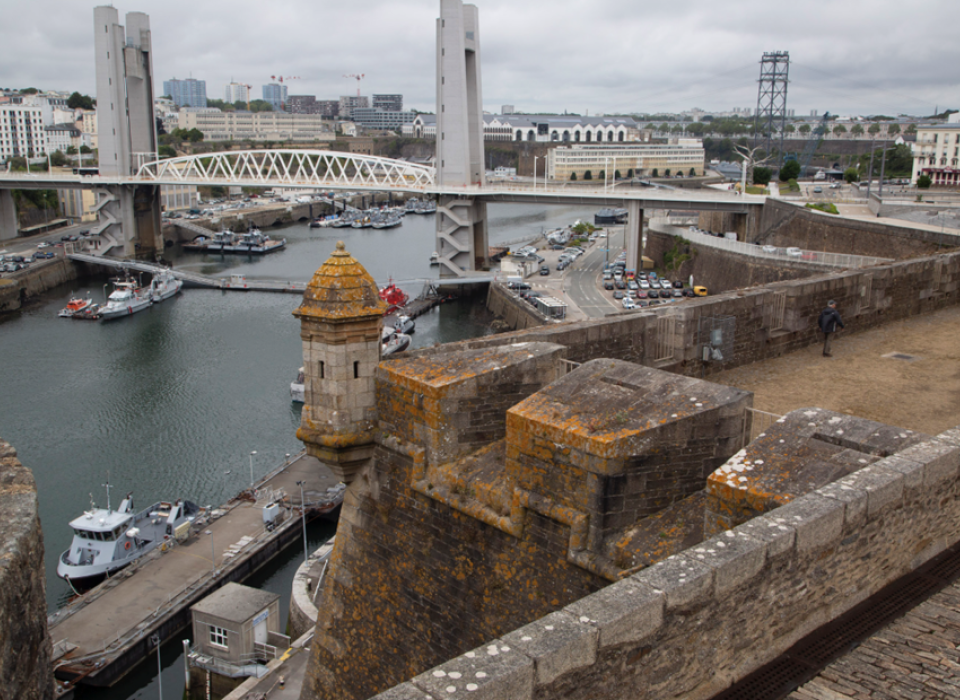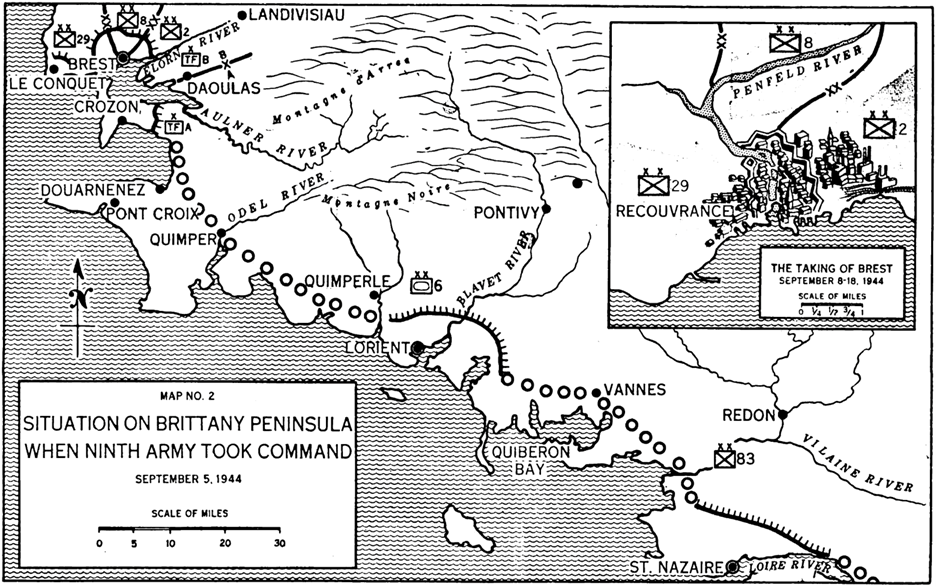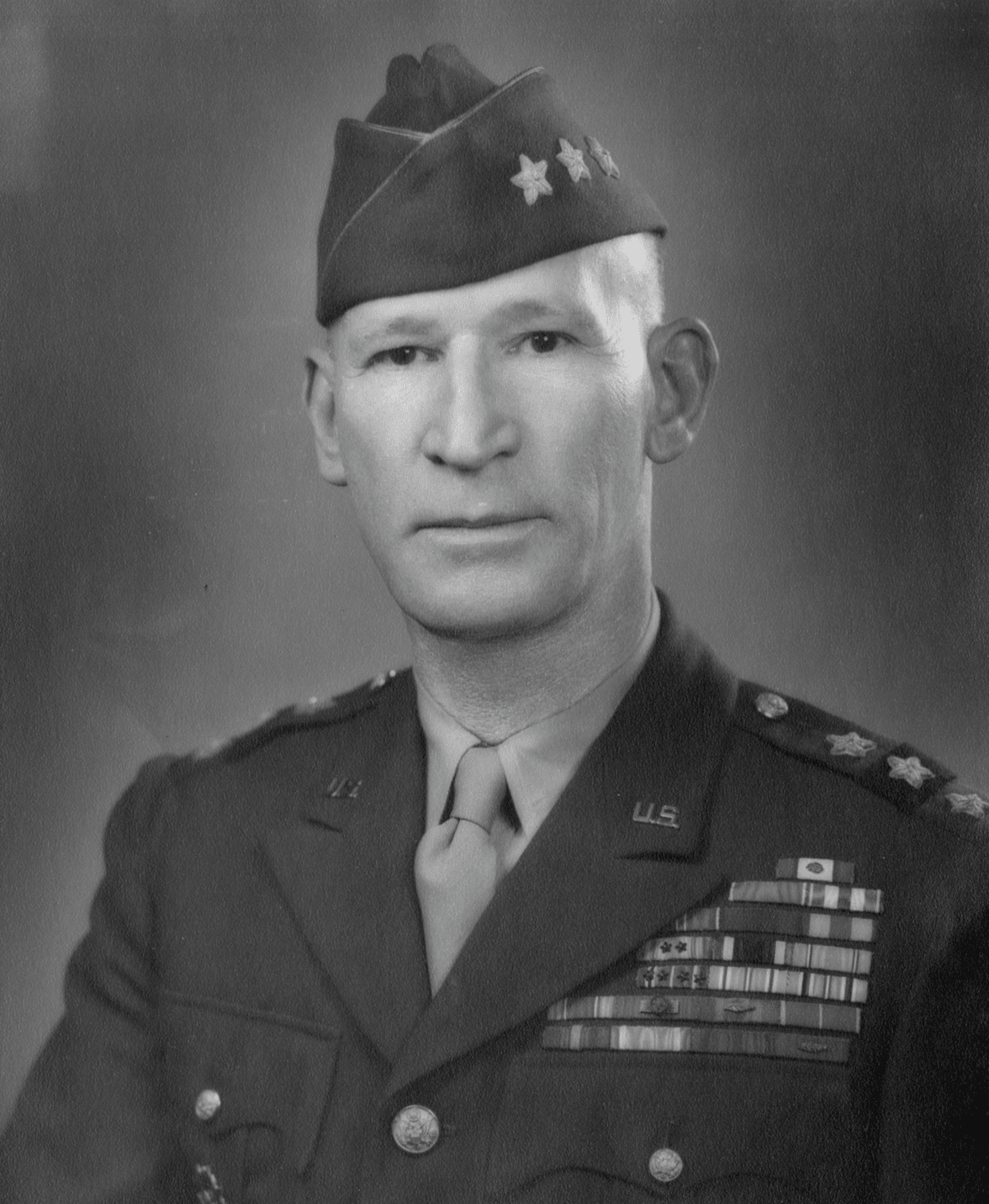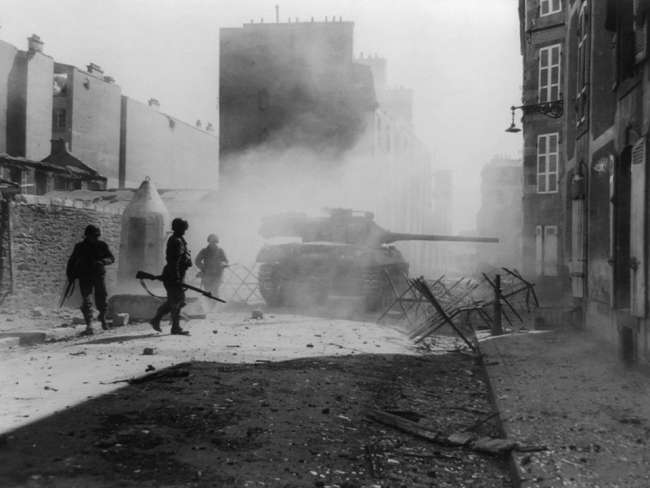Top Photo: View of the ancient fortress of Brest, an imposing structure overlooking the city, 2019. Photo by Mark Calhoun
After the success of Operation Cobra on July 25, 1944, the Allies broke through German lines near Saint-Lô in Normandy, restoring mobility to a front that had stagnated since D-Day. As the Allies pursued the routed German army, General Omar Bradley, commander of the 12th Army Group, ordered Lieutenant General George Patton, commander of Third US Army, to drive rapidly to the east and occupy Nantes and Angers, France. Bradley’s orders also directed Patton to capture Brest in Brittany, while securing the Allies’ southern flank along the Loire River.[1]
Directed to conduct these missions with a minimal number of troops, Patton ordered the 6th Armored Division to drive west and capture the port city in a coup de main. Allied confidence was high, but capturing a fortified city was not a suitable mission for an armored division. Approaching Brest on August 7, it was clear that the enemy defenses were quite formidable. Still, it was over two weeks before Bradley committed more forces to Brittany.
Finally, on August 25, Bradley ordered Major General Troy Middleton, commander of VIII US Corps, to move south into Brittany and, under Third Army command, take over the mission of liberating Brest. Upon his arrival, Middleton committed the 2nd, 8th, and 29th Infantry Divisions to the fight at Brest. He sent the 6th Armored and 83rd Infantry Divisions southeast to conduct security operations along the Loire River.
Although 12th Army Group planners expected the liberation of Brest to take only one week, the strength of the city’s ancient stone-walled fortress, the fanatical resistance of the German forces occupying it, and chronic shortages of ammunition frustrated Middleton’s efforts. The command-and-control (C2) situation made matters worse. With the Third Army conducting offensive operations to exploit the post-Operation Cobra breakout hundreds of miles to the east, Patton was too far away to influence VIII Corps. Middleton, too, faced significant challenges. With three divisions engaged around the city, and two more on security operations along the 300-mile stretch of the Loire River from Saint-Nazaire to Orléans, Middleton and his small corps staff lacked the capacity to provide effective C2.[2]
Another two weeks passed, as logistics challenges plagued the operation. Artillery ammunition shortages forced the 29th Infantry Division to suspend offensive operations on three separate days between August 31 and September 7, with no increase in supply expected. The situation frustrated Middleton to the point that he sent a letter to the Third Army staff telling them to either send him sufficient resources to complete his mission or relieve him of command. Finally, the arrival of a new field army headquarters in France offered a solution to the problem. After a period of training and preparation that included many visits to front-line units, Lieutenant General William H. Simpson’s Ninth US Army assumed operational status on September 5 under the 12th US Army Group at Rennes, France. Its first mission took the Ninth Army to Brittany, where Simpson quickly saw that Middleton’s situation was dire.
The contrast between Generals Simpson and Patton could not have been starker. Joseph Balkoski, historian of the 29th Infantry Division, described Simpson as “one of the most esteemed general officers in the US Army in 1944—an expert trainer of troops and very much Patton’s opposite, a man to whom logic and humility, rather than bravado and egotism, came entirely naturally.”[3] Bradley ordered Simpson to take command of VIII Corps, reduce the Brittany Peninsula, and ensure security of the army group’s southern flank along the Loire River.[4]
With no reinforcements forthcoming, Simpson’s task might have seemed insurmountable. Still, a field army staff is larger than a corps staff, with more senior and experienced personnel, giving it a greater capacity to deal with issues like the logistics shortfalls plaguing the VIII Corps. Further, Middleton finally had a superior headquarters located nearby and focused on the fighting in Brittany with no distractions. Simpson evaluated the situation and took quick action to improve it.
Simpson saw that Middleton could not manage both the fighting around Brest and the protection of the corps’ 300-mile flank along the Loire River. To resolve this difficulty, Simpson on September 10 transferred the 6th Armored Division and the 83rd Infantry Division from VIII Corps to Ninth Army control. This allowed Middleton to concentrate on the siege of Brest, while Simpson’s staff directed the wide-ranging flank security mission.
To increase availability of ammunition, Simpson’s staff coordinated with Communications Zone personnel to prioritize shipments to the VIII Corps. To speed the delivery of ammunition to the artillery units around Brest, Ninth Army arranged for ammunition supply ships to land at nearby smaller ports and beaches.[5] Simpson’s intervention paid dividends, and soon VIII Corps had sufficient ammunition to maintain several consecutive days of heavy pressure on the enemy—something that had been impossible just a week prior.
Middleton renewed the attack on September 8, and the tide finally started to turn in his favor. Still, it would take another ten days of hard fighting before the fortress finally fell on September 18. Brest was heavily fortified, with an outer layer of defenses that, once broken through, led to an urban environment where soldiers would face deadly close combat, all before finally reaching the stone-walled fortress in the city center.
As the battle reached its final stage, frustration grew among both the troops and their commanders. Losses had been significant. The 29th Infantry Division, for example, suffered 1,200 casualties by September 1, with the toughest fighting still to come. Leaders grew increasingly frustrated as delays stretched the battle well beyond what planners expected. Finally, by mid-September, Middleton’s troops reached the central fortress.
Simpson sensed a bit of sluggishness as he moved around the battlefield, visiting commanders and troops at the front, so he spent the battle’s final days at division and regimental headquarters, where he could influence events. Asked about it after the war, Simpson recalled:
“At times it looked a little slow. I got a little impatient about it. I remember several times that while I didn’t try to take over command of any unit, I did provide some indirect suggestions that might have helped some. My staff, especially my G-3, were in constant contact with the corps and knew how things were going. Of course, I visited there quite often as did the staff.”
Although Simpson downplayed his role, his G-3 operations officer, Brigadier General Armistead D. Mead Jr., remembered it differently: “[General Simpson] was at the right place at the right time to get it done.”
The GIs finally penetrated the fortress walls on September 17, leading the garrison commander, General Bernhard Ramcke, to surrender the following day.[6] Simpson did not participate in the surrender, leaving that honor to Major General Donald A. Stroh, commander of the 8th Infantry Division.
In the wake of this costly victory, inspections soon revealed that the Germans had inflicted such significant damage to the port facilities that the repairs needed to make them operational were simply impractical. The authors of Ninth Army’s official history found it “bitterly ironical” that the Americans fought so hard for a useless port, suffering nearly 10,000 casualties in the process.[7]
Historians have debated the logic of fighting to liberate Brest, with some arguing that it would have made more sense to simply bypass the city and isolate the garrison, as the Allies did in several locations during the campaign in northwest Europe. Nevertheless, planners identified Brest as a key objective before D-Day, believing it would prove useful as a port. By the time planners started to realize Brest would not be especially useful after all, the battle was already joined.
References:
-
[1] Headquarters, 12th Army Group, “Letter of Instructions Number Four,” August 8, 1944, in Report of Operations, Final After Action Report, 12th Army Group, v. 5, G-3 Section, US Army Combined Arms Research Library, Fort Leavenworth, KS.
-
[2] T. W. Parker Jr., and William J. Thompson, eds., Conquer: The Story of the Ninth Army (Washington, DC: Infantry Journal Press, 1947), 25-27.
-
[3] Joseph Balkoski, From Beachhead to Brittany: The 29th Infantry Division at Brest, August-September 1944 (Mechanicsburg, PA: Stackpole, 2008), 88.
-
[4] Headquarters, 12th Army Group, “Letter of Instructions Number Eight,” September 10, 1944, in Report of Operations, Final After Action Report, 12th Army Group, v. 5, G-3 Section, US Army Combined Arms Research Library, Fort Leavenworth, KS.
-
[5] Parker Jr., and Thompson, 28, 38-39.
-
[6] Martin Blumenson, ed., Breakout and Pursuit, US Army in World War II (Washington, DC: United States Army Center of Military History, 1961; reprint, 2005).
-
[7] Parker Jr., and Thompson, 35.
Mark T. Calhoun, PhD
Mark T. Calhoun, PhD, is a former Senior Historian at the Jenny Craig Institute for the Study of War and Democracy.
Cite this article:
MLA Citation:
APA Citation:
Chicago Style Citation:









![Max Fuchs, New York City cantor, sings as Rabbi Sydney [sic] Lefkowitz, Richmond, VA, conducts the first Jewish services from Germany.](/sites/default/files/styles/max_650x650/public/2025-10/image1.jpg)



